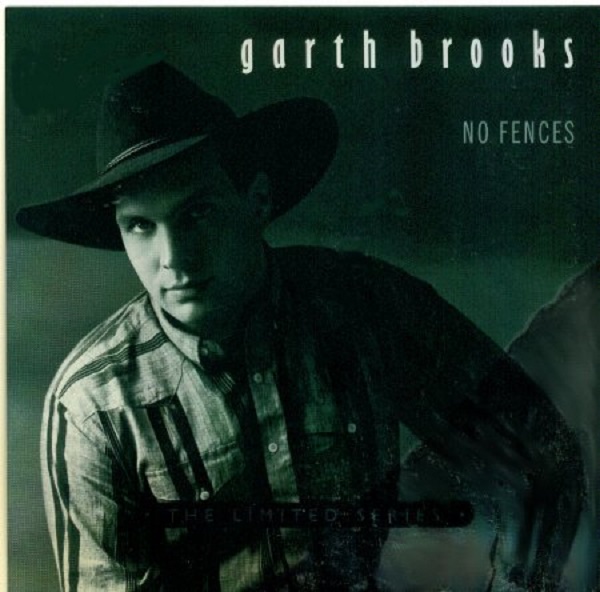30 Years Later: Garth Brooks’ ‘No Fences’ Album
A classic – and now more than 18 million sold!

Garth Brooks swung for the fences and smashed one out of the park when he released his 1990 album, No Fences. Like a home run-hitting hero, baseball fan Brooks put up some mighty big numbers with this follow-up to his 1989 self-titled debut. The record spent a whopping 41 weeks at No. 1 on the Billboard Hot Country Albums chart, and perhaps more impressively, hit No. 3 on the Billboard Hot 200, which lists all genres of music. By the end of 1990, No Fences had already passed the two million mark in sales. No Fences went on to sell more than 17 million copies and was recently certified for 18 million in February, making it now the third largest-selling country album in history.
Brooks had established solid rookie credentials with his debut album, which contained some of his earliest hits like his first No. 1 single, “If Tomorrow Never Comes,” and the poignant ballad “The Dance.” Released in April of 1989, it peaked at No. 2 on the albums chart and reached Platinum status for sales of one million copies the following year. “The Dance,” in particular, helped expose Brooks to a wider audience with its dual stories, combining a broken relationship with a broader theme of taking chances and going for your dream. The music video for “The Dance” featured excerpts from the lives of President John F. Kennedy, Dr. Martin Luther King Jr., singer Keith Whitley, and others who died as they pursued glory. This was not your ordinary country artist who preferred to stay on the sidelines and not speak of important topics.
That first album set the stage for No Fences, which came roaring out of the box on August 27th, 1990. On the 30th anniversary of its release, we look back at the smash singles spawned by No Fences, along with its still-viable impact and legacy.

THE HITS
No Fences yielded four straight No. 1 singles, beginning with “Friends in Low Places,” which hit radio about a week prior to the album. The rollicking tune, carrying with it an “us-vs-them” skewering of the upper class, seemed perfectly tailored for the stage, practically begging fans to sing along at the end of the evening, fueled by concession stand libations. “Friends in Low Places” vaulted to No. 1 in October of 1990, staying at the top for a total of four weeks. “If you want to know who Garth Brooks is,” Brooks noted on the A&E television special Garth Brooks: The Road I’m On, “’Friends in Low Places’ is Garth Brooks.” The tune took home the CMA award for Single of the Year in 1991. Many Garth fans like to think of it as his signature song, even 30 years down the road.
Brooks followed with “Unanswered Prayers” and “Two of a Kind, Workin’ on a Full House,” both chart-toppers. With his fourth and final single from the album in May of 1991, “The Thunder Rolls,” Brooks pushed the boundaries of country music, showing that he was brave enough to tackle tough topics, regardless of the blowback. “The Thunder Rolls” depicted a story of domestic violence, played out with a man whose wife knows that he’s been unfaithful to her. The provocative lines, As the storm blows on out of control/Deep in her heart the thunder rolls, sums up the anger in the woman’s betrayed heart. Written by Brooks and songwriter Pat Alger, the song was originally recorded by Tanya Tucker for an upcoming album. But Tucker ended up dropping it. Brooks recorded it and placed in on No Fences.
Allen Reynolds, who produced No Fences, always believed that “The Thunder Rolls” was the most powerful statement that Brooks had ever made. Co-writer Alger pointed to the song’s believability, however uncomfortable it may have seemed. “It’s about the consequences of infidelity,” Alger noted on Garth Brooks: The Road I’m On. He referred to the lines, He’s headin’ back from somewhere/That he never should have been. “How many of us have been to that place?” Alger said, in wry, rhetorical fashion. Brooks had actually wanted to make a record with the sounds of thunder in the background, and Reynolds was able to accommodate. He had some tapes from a past session that contained thunder and rain tracks. As the song reached the title line, the thunder sounds played over the words, creating a dramatic tension. “It lined up perfectly,” Brooks said on his website, discussing the 2017 deluxe book, Garth Brooks The Anthology Part 1: The First Five Years. He further described the recording as a “meant-to-be thing.”
The accompanying music video, starring a heavily disguised Brooks as the cheating husband, portrayed the song’s theme in graphic fashion. It proved, in fact, too graphic and violent for a number of video outlets, including TNN and CMT, which banned the clip from their playlists. In the midst of the controversy, Brooks actually discussed the possibility of never making another video. But in an ironic twist of fate, “The Thunder Rolls” won the 1991 CMA award for Music Video of the Year.
Brooks and Alger, along with songwriter Larry Bastian, also collaborated on “Unanswered Prayers,” based on a true-life incident. In the liner notes for his CD The Hits, Brooks explained that the setup, a man running into his high school sweetheart, happened to him and his then-wife Sandy. “In October of ’89,” Brooks wrote, “I saw my old high school flame.” He added, “This is probably the truest song I have ever been involved with as a writer. Every time I sing this song, it teaches me the same lesson – happiness isn’t getting what you want, it is wanting what you’ve got.”
THE LEGACY
Experts and historians agree that No Fences established Brooks as a global superstar, not just a home-grown phenomenon. Besides its chart-topping success in the U.S., the album hit No. 1 on the Irish Albums Chart and No. 2 on the Canadian RPM Country Albums chart. It was also Brooks’ first album to be issued in Europe, reaching No. 1 in the UK.
With the momentum from No Fences, Brooks’ domestic fortunes exploded. The album helped launch Brooks as a bold and fearless artist who delighted in breaking away from traditions, as essentially foreshadowed in the album’s title. Brooks adeptly mixed country with rock, pop, and folk into a pleasing amalgam that fans of all tastes could embrace. His stage shows, which Brooks often noted were inspired by flashy visual rockers like KISS, became renowned as lively, non-stop affairs, relentless from the opening number to the closing encores. There was simply no other country star like him. But fans who normally gravitated toward pop or arena-style rock also found a kindred spirit in the country boy from Oklahoma. By the end of the 1990’s, No Fences ranked as the fourth best-selling album of the decade, in any musical style. And Brooks was arguably music’s biggest and most-talked-about figure.
No Fences copped Album of the Year honors from both the CMA and ACM. And with the overwhelming sales generated by No Fences, country proved that it had the cache to become an album format. The album landed at the three million mark in 1991, and 10 million a mere two years later. Prior to this, multi-Platinum albums in country music were rare. Now, they’re practically the norm, and No Fences helped set that bar. Through that album, Brooks changed the shape and sound of country music.


